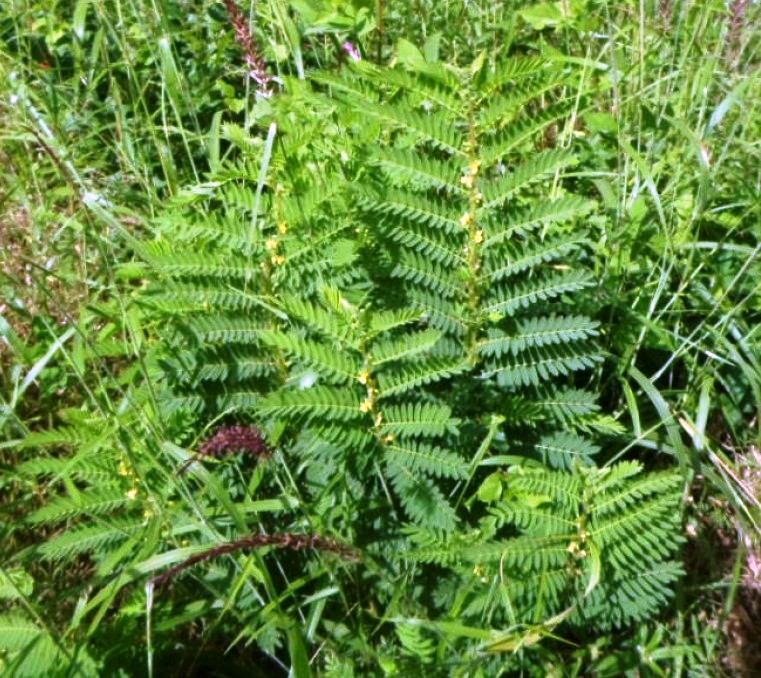Cassia nigricans

|
|
Chamaecrista nigricans Common Names: Black Partridge Pea, Black Cassia,
Nigricans Partridge Pea Scientific
Classification Kingdom: Plantae Clade: Tracheophytes Clade: Angiosperms Clade: Eudicots Clade: Rosids Order: Fabales Family: Fabaceae Genus: Chamaecrista Species: C. nigricans Synonyms: Cassia nigricans Vahl, Cassia micrantha Guill. & Perr., Cassia harneyi Specht, Chamaecrista harneyi (Specht) Govaerts Morphological Description Chamaecrista nigricans is an erect herb or undershrub, typically 25–45 cm tall,
occasionally reaching 1.8 meters in favorable conditions. Its key
characteristics include: · Stems: Pubescent, with short, crisped, and longer spreading hairs;
green to purplish, often woody at the base in older plants (Fern, 2024). · Leaves: Pinnate, oblong (3–10 cm × 2–4 cm), with 7–15 pairs of
linear-oblong leaflets (5–15 mm × 2–4 mm); glabrous to sparsely hairy; stipules
lanceolate (Burkill, 1995). · Flowers: Small, yellow, 3.5–4.5 mm long, in axillary or terminal
racemes; petals 5, ovate; bloom seasonally, attracting pollinators like bees
(Plants of the World Online, n.d.). · Fruit: Erect pods (1.7–2.4 cm long), linear-oblong, containing 4–8
brown, obovate or rhombic seeds (2.5–4 mm); pods split to release seeds. Distribution and Habitat Chamaecrista nigricans is widely distributed across tropical and subtropical
regions, thriving in diverse ecological niches: · Geographic Range: Native to Cape Verde, tropical Africa
(Senegal to Sudan, south to Angola), Arabian Peninsula, Pakistan, and India;
common in Nigeria’s savanna and forest margins (Kew Science, n.d.). · Habitat: Grows in seasonally dry tropical biomes, including savanna
grasslands, open woodlands, roadsides, and disturbed areas; prefers
well-drained, sandy or loamy soils (pH 5.5–7.0) with annual rainfall of
950–1,400 mm; occurs at elevations up to 1,200 m (Fern, 2024). · Ecological Role: Acts as a pioneer species in disturbed
soils; supports pollinators; nitrogen-fixing roots enhance soil fertility
(Burkill, 1995). Ethnopharmacology Chamaecrista nigricans (syn. Cassia nigricans) is a leguminous shrub
widely used in African and Indian traditional medicine for treating fever,
malaria, stomach disorders, diarrhea, ulcers, and skin diseases. Its leaves and
roots are employed as purgatives, antimicrobials, and topical remedies for
wounds and inflammation, and some traditions use it to induce labor.
Phytochemical studies have identified anthraquinones such as emodin,
chrysophanol, and physcion, which may contribute to its analgesic, anti-inflammatory,
and ulcer-protective properties. Experimental data also suggest potential
antimalarial, antidiabetic (via α-amylase inhibition), and antimicrobial
effects. · Antimicrobial: In Nigeria, leaf decoctions treat skin infections.
Methanolic leaf extracts inhibited Mycobacterium bovis (MIC: 625 µg/mL), supporting
anti-tuberculosis use; also effective against Staphylococcus aureus and Escherichia coli (MIC: 0.5–1 mg/mL), linked to flavonoids
and tannins (Egharevba et al., 2010). · Antipyretic: In Senegal, leaf infusions reduce fever.
Ethnopharmacological surveys confirm its use for fever and headaches, likely
due to phenolic compounds, though specific studies are limited (Burkill, 1995). · Gastrointestinal Relief: In Nigeria, aerial parts treat stomach
aches. The astringent properties of tannins support this use, though direct
validation is needed (Adjanohoun et al., 1989). · Insect Repellent: In Ghana, crushed leaves are used as an
insect repellent. Essential oils from aerial parts showed larvicidal activity
against Anopheles gambiae, validating its pesticidal use (Dantanko & Malann, 2020). · Anti-inflammatory Potential: In Nigeria, leaf poultices manage
swelling. While not directly studied, related Chamaecrista species show anti-inflammatory effects via
flavonoids, suggesting similar potential (Agyare et al., 2014). ⚠ Toxicity Profile: Chamaecrista nigricans has no widely reported toxic effects, but
limited toxicity data exists. Ethanol leaf extracts showed no acute toxicity
(LD₅₀ > 5,000 mg/kg) in rats, but chronic use may cause mild liver enzyme
elevation (ALT increased by 10% after 30 days). High doses (>1,000 mg/kg)
may cause gastrointestinal discomfort. Use is contraindicated in pregnancy and
for children due to insufficient safety data. Potential heavy metal
contamination in wild-harvested plants requires caution (Awounfack et al.,
2016). Phytochemistry The bioactivity of Chamaecrista nigricans is driven by its diverse chemical
constituents, based on studies of the species and related Chamaecrista taxa: · Flavonoids: Quercetin, kaempferol, apigenin, contributing to
antimicrobial and anti-inflammatory effects (Egharevba et al., 2010). · Tannins: Present in leaves, supporting astringent and
gastrointestinal benefits (Agyare et al., 2014). · Phenolics: Gallic acid, chlorogenic acid, enhancing antioxidant and
antimicrobial properties (Adjanohoun et al., 1989). · Alkaloids: Trace amounts, potentially aiding antipyretic effects
(Burkill, 1995). · Essential Oils: Terpenoids like γ-terpinene, with
larvicidal and repellent activity (Dantanko & Malann, 2020). Additional Uses · Pesticidal: Aerial parts are used as a natural pesticide in Nigeria,
repelling insects in stored grains and fields (Fern, 2024). · Fodder: Leaves are used as forage for livestock in Senegal during dry
seasons, with moderate protein content (10–15%) (Burkill, 1995). · Cultural: In Yoruba culture, leaves are used in rituals for spiritual
cleansing, reflecting ethnobotanical significance (Adjanohoun et al., 1989). · Ecological: Planted in agroforestry to enhance soil fertility through
nitrogen fixation; stabilizes degraded soils in savanna ecosystems (Fern,
2024). References
External Links
More Pictures
|
|
| Compounds of Cassia nigricans | |
| References |